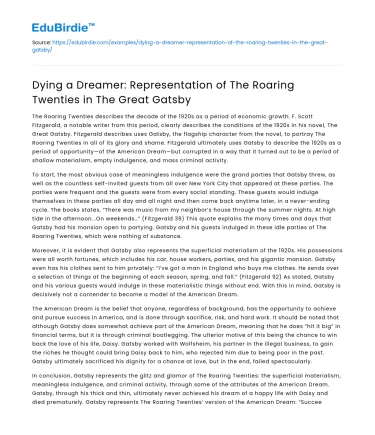The Roaring Twenties describes the decade of the 1920s as a period of economic growth. F. Scott Fitzgerald, a notable writer from this period, clearly describes the conditions of the 1920s in his novel, The Great Gatsby. Fitzgerald describes uses Gatsby, the flagship character from the novel, to portray The Roaring Twenties in all of its glory and shame. Fitzgerald ultimately uses Gatsby to describe the 1920s as a period of opportunity—of the American Dream—but corrupted in a way that it turned out to be a period of shallow materialism, empty indulgence, and mass criminal activity.
To start, the most obvious case of meaningless indulgence were the grand parties that Gatsby threw, as well as the countless self-invited guests from all over New York City that appeared at these parties. The parties were frequent and the guests were from every social standing. These guests would indulge themselves in these parties all day and all night and then come back anytime later, in a never-ending cycle. The books states, “There was music from my neighbor’s house through the summer nights. At high tide in the afternoon...On weekends…” (Fitzgerald 39) This quote explains the many times and days that Gatsby had his mansion open to partying. Gatsby and his guests indulged in these idle parties of The Roaring Twenties, which were nothing of substance.
Save your time!
We can take care of your essay
- Proper editing and formatting
- Free revision, title page, and bibliography
- Flexible prices and money-back guarantee
Moreover, it is evident that Gatsby also represents the superficial materialism of the 1920s. His possessions were all worth fortunes, which includes his car, house workers, parties, and his gigantic mansion. Gatsby even has his clothes sent to him privately: “I’ve got a man in England who buys me clothes. He sends over a selection of things at the beginning of each season, spring, and fall.” (Fitzgerald 92) As stated, Gatsby and his various guests would indulge in these materialistic things without end. With this in mind, Gatsby is decisively not a contender to become a model of the American Dream.
The American Dream is the belief that anyone, regardless of background, has the opportunity to achieve and pursue success in America, and is done through sacrifice, risk, and hard work. It should be noted that although Gatsby does somewhat achieve part of the American Dream, meaning that he does “hit it big” in financial terms, but it is through criminal bootlegging. The ulterior motive of this being the chance to win back the love of his life, Daisy. Gatsby worked with Wolfsheim, his partner in the illegal business, to gain the riches he thought could bring Daisy back to him, who rejected him due to being poor in the past. Gatsby ultimately sacrificed his dignity for a chance at love, but in the end, failed spectacularly.
In conclusion, Gatsby represents the glitz and glamor of The Roaring Twenties: the superficial materialism, meaningless indulgence, and criminal activity, through some of the attributes of the American Dream. Gatsby, through his thick and thin, ultimately never achieved his dream of a happy life with Daisy and died prematurely. Gatsby represents The Roaring Twenties’ version of the American Dream: “Succeed through fraudulent business. Dream and die a dreamer.”






 Stuck on your essay?
Stuck on your essay?

